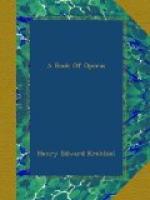There is no doubt in my mind but that Wagner’s purpose in “Die Meistersinger” was to celebrate the triumph of the natural, poetical impulse, stimulated by healthy emotion and communion with nature, over pedantry and hide-bound conservatism. In the larger study of the opera made in another place, I have attempted to show that the contest is in reality the one which is always waging between the principles of romanticism and classicism, a contest which is essentially friendly and necessary to progress. The hero of the comedy is not Walther, but Sachs, who represents in himself both principles, who stands between the combatants and checks the extravagances of both parties. {3}
Like Beethoven in his “Leonore” overtures written for the opera “Fidelio,” Wagner constructs the symphonic introduction to his comedy so as to indicate the elements of his dramatic story, their progress in the development of the play, and, finally, the outcome. The melodies are of two sorts conforming to the two parties into which the personages of the play can be divided; and, like those parties, the melodies are broadly distinguished by external physiognomy and emotional essence. Most easily recognized are the two broad march tunes typical of the mastersingers and their pageantry. One of them has already been presented. Like its companion,—
[Musical excerpt]
which opens the prelude, it is a strong, simple melody, made on the intervals of the diatonic scale, square-cut in rhythm, firm and dignified, and, like the mastersingers, complacent and a trifle pompous in stride. The three melodies which are presented in opposition to the spirit represented by the mastersingers and their typical music, are disclosed by a study of the comedy to be associated with the passion of the young lovers, Walther and Eva. They differ in every respect—melodic, rhythmic, and harmonic,—from those which stand for the old guildsmen and their rule-of-thumb notions. They are chromatic, as see this:—
[Musical excerpt]
and this (which is the melody which in a broadened form becomes that of Walther’s prize song):—
[Musical excerpt]
and this, which is peculiarly the symbol of youthful ardor:—
[Musical excerpt]
Their rhythms are less regular and more eager (note the influence of syncopation upon them); they are harmonized with greater warmth and infused with greater passion. In the development of the prelude these melodies are presented at first consecutively, then as in conflict (first one, then another pushing forward for expression), finally in harmonious and contented union. The middle part of the prelude, in which the opening march tune is heard in short, quick notes (in diminution, as the theoreticians say) maybe looked upon as caricaturing the mastersingers, not in their fair estate, but as they are satirized in the comedy in the person of Beckmesser.




